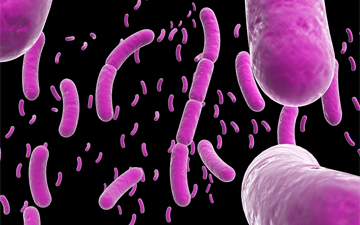Bacillus subtilis, known also as the hay bacillus or grass bacillus, is a Gram-positive, catalase-positive bacterium commonly found in soil.[3] A member of the genus Bacillus, B. subtilis is rod-shaped, and has the ability to form a tough, protective endospore, allowing the organism to tolerate extreme environmental conditions. Unlike several other well-known species, B. subtilis has historically been classified as an obligate aerobe, though recent research has demonstrated that this is not strictly correct.[4]
B. subtilis is not a human pathogen. It may contaminate food but rarely causes food poisoning.[5] B. subtilis produces the proteolytic enzyme subtilisin. B. subtilis spores can survive the extreme heat during cooking. B. subtilis is responsible for causing ropiness — a sticky, stringy consistency caused by bacterial production of long-chain polysaccharides — in spoiled bread dough.
B. subtilis can divide symmetrically to make two daughter cells (binary fission), or asymmetrically, producing a single endospore that is resistant to environmental factors such as heat, acid, and salt, and which can persist in the environment for long periods of time. The endospore is formed at times of nutritional stress, allowing the organism to persist in the environment until conditions become favorable. Prior to the process to produce the spore the bacterium might become motile, through the production of flagella, and also take up DNA from the environment.
(From Wikipedia, November 1, 2010)
– – –
Grows as a unicellular rod, seldom as chains. Degrades pectin and polysaccharides in plant tissues, and some strains cause rots in live potato tubers. Endospores are widespread. Vegetative organisms take part in various stages in the early breakdown of materials of plant and animal origin. Grows in non acid food under aerobic conditions. Causative agent of ropy (slimy) bread. Very extensively studied.
(From Biopedia via EOL)




